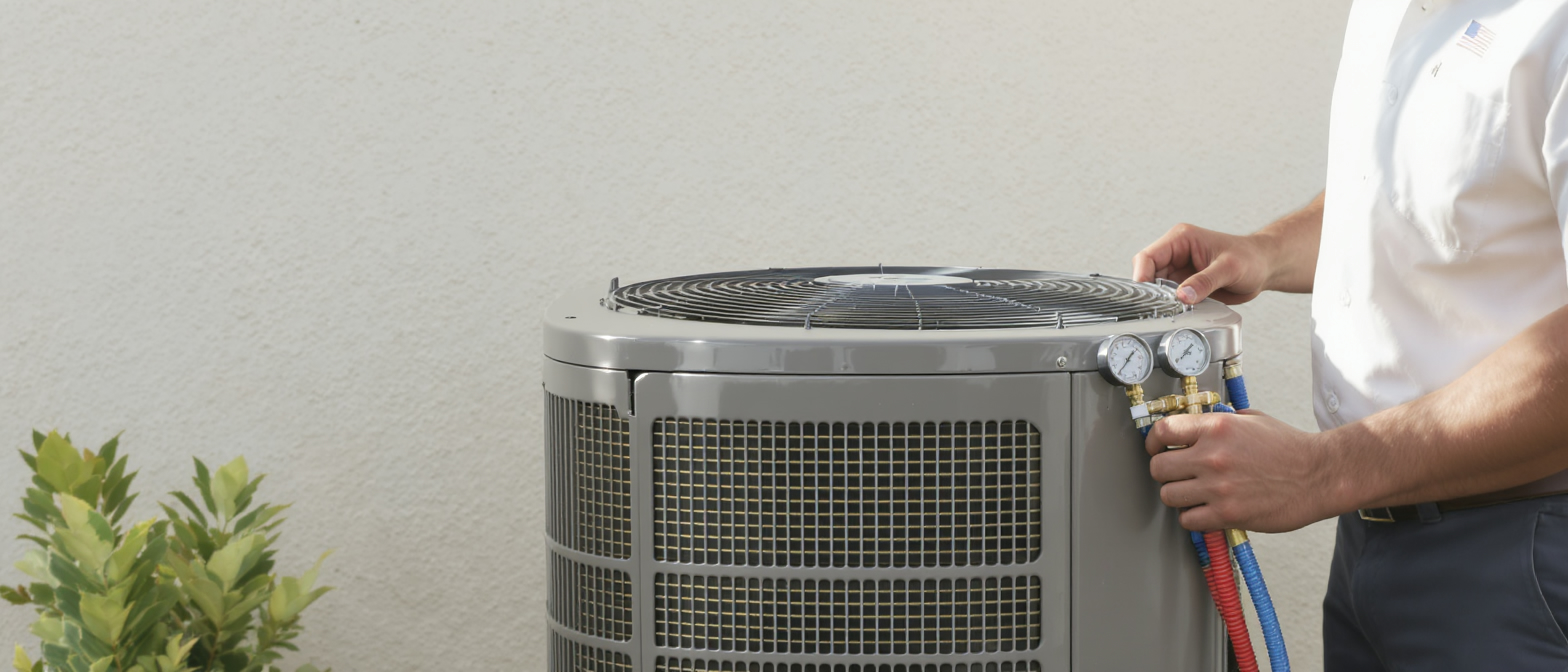How Often Should You Check AC Refrigerant Pressure?

Quick answer
Most homeowners do not need to check AC refrigerant pressure regularly. Pressures should be measured by a certified technician during planned maintenance or when clear performance symptoms appear. Modern systems, especially inverter mini split and variable-speed heat pumps, require more than a simple PSI reading—proper diagnostics use superheat and subcooling, airflow verification, and manufacturer specifications.
What refrigerant pressure really tells you
Refrigerant pressure is just one piece of the puzzle. A healthy system depends on the correct refrigerant mass, clean coils, proper airflow, accurate metering, and sound electrical operation. Pressure can look “normal” even when charge is wrong. That’s why pros evaluate:
- Static vs. running pressure
- Superheat and subcooling targets
- Airflow and filter status
- Outdoor ambient and indoor return conditions
- Metering device behavior (TXV/EEV)
Inverter systems and mini splits continuously modulate capacity. Their control logic can produce widely varying pressures, so relying on a single gauge set reading without superheat/subcooling and factory data can mislead even experienced DIYers.
How often should pressures be checked?
- During professional maintenance: Once per year for cooling-only systems; biannual for heat pumps operating both heating and cooling. A technician will review refrigerant pressure alongside superheat and subcooling to confirm charge.
- When symptoms appear: If your AC shows warning signs (see list below), pressures and temperatures should be checked promptly.
- After a refrigerant-side repair: Any opened system requires evacuation, precise weigh-in, and verification by superheat/subcooling and pressures.
- Post-incident or insurance-driven checks: After events like power surges, storm damage, or line-set impact, insurers often require documentation from a qualified specialist.
Why DIY pressure checks can be risky
- Regulatory issues: In the U.S., handling refrigerant typically requires EPA Section 608 certification. Improper connections can vent refrigerant, violating federal rules.
- Safety hazards: Refrigerants are under high pressure; frostbite and eye injury are real risks. Some blends are mildly flammable.
- System contamination: Non-dedicated hoses and manifold gauges can introduce moisture or air. That leads to acid formation, restricted metering devices, and compressor failure.
- Misdiagnosis: Low pressure doesn’t always mean “low refrigerant.” You might have airflow issues, dirty coils, undersized ducts, or a failing TXV/EEV.
- Insurance and warranty: Many policies and manufacturer warranties require a licensed HVAC technician to document refrigerant work.
Signs that suggest a pro should test your system
- Warm air or longer-than-usual run times
- Uneven cooling or rising indoor humidity
- Ice on the refrigerant lines or evaporator coil
- Hissing/bubbling noises near the line set
- Higher utility bills without a heat wave
- Frequent short cycling or error codes on a mini split
Special notes for heat pumps and inverter mini splits
Heat pumps reverse the refrigerant flow. Pressures differ between heating and cooling modes, and outdoor temperature swings affect readings. Inverter mini split systems vary compressor speed; they frequently require manufacturer-specific diagnostic modes, charge-by-weight procedures, and temperature/pressure evaluation under stabilized conditions. A simple refrigerant pressure check is not enough.
Southern California considerations
Our region’s long cooling season, dry heat, and coastal corrosion can magnify small issues. Dust-clogged filters lower evaporator temperature and can mimic a low-charge condition. Likewise, prolonged mild weather can mask problems until the first heat wave.
Service area includes Los Angeles County and nearby communities such as Pasadena, Burbank, Glendale, Long Beach, Santa Monica, and the San Fernando Valley; Orange County cities like Anaheim, Irvine, and Santa Ana; Ventura County communities including Thousand Oaks, Oxnard, and Ventura; and Western Riverside County areas such as Corona, Riverside, Murrieta, and Temecula.
What a professional refrigerant evaluation includes
- Confirm equipment model and factory charging method (fixed or weighed-in charge).
- Check airflow first (filters, coils, blower speed, static pressure).
- Measure line temperatures and pressures, then calculate superheat and subcooling.
- Compare to manufacturer targets adjusted for indoor/outdoor conditions.
- Perform leak detection if charge is low; recover, evacuate, and weigh in refrigerant per spec.
- Document findings for warranty or insurance records.
So, do you need regular homeowner pressure checks?
No. Schedule professional maintenance at sensible intervals and watch for performance symptoms. The combination of pressure, superheat, subcooling, and airflow tells the real story, and it should be interpreted by an EPA Section 608–certified technician using clean, calibrated tools.
About #1 AC Guys
#1 AC Guys is a family HVAC company in Southern California serving Los Angeles County and nearby areas, including Orange County, Ventura County, and Western Riverside County. We specialize in both commercial and residential work, with a focus on large and complex projects. Our core mission is healthy air at home for healthy life.
We are a fourth-generation family of engineers with 80+ years of engineering experience. Our engineers have received training at manufacturer facilities of Fujitsu (Japan), Mitsubishi Electric (Thailand), Midea (China), Gree (China), and Haier (China). This foundation supports careful diagnostics and best practices for AC refrigerant pressure checks, superheat and subcooling verification, and long-term system reliability.
Yasmine is currently an Associate Professor of Psychology at Mount Saint Mary College where she teaches a wide array of courses in the Psychology department. She is a Fulbright Scholar spent a year working at the Medical Decision Making Center at Ono Academic College in Israel.
Yet, as many higher education professionals can surely attest to, I have also witnessed the other challenge in group decision making. In academia, engaging in critical dissent is encouraged (reviewed by Jetten & Hornsey, 2014), and while this is a fine attribute, practically,
